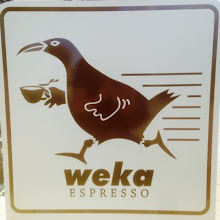Nuku‘alofa is the capital city of the
Kingdom of Tonga. We'd arranged a private tour of the island of
Tongatapu with
Toni's Tours. Toni is originally from England and has been living in Tonga for 25 years. "Tonga is home. I'm a Tongan," he told me.
They say that time slows down in Tonga. The open road speed limit is 70 km/h and the hot, sticky, dusty climate does the rest. Pigs are everywhere around houses and along the side of the road, bringing a whole new meaning to the term
free range. There are fishing pigs all around the lagoon searching for whatever food they can find.
 |
| A fishing pig |
We began our tour by driving around the lagoon to
Niutoua.
Ha‘amonga ‘a Maui is at the eastern most point of the island. Tonga claims to be the very first country in the world to see the dawn of every new day, something this Chatham Islander finds somewhat contentious. The top stone of the ancient trilithon monument lines up with the skyline on the longest day of the year.
 |
| Haʻamonga ʻa Maui trilithon |
We drove to the scenic Captain Cook's landing point. There is a makeshift craft centre at the site where you can buy trinkets while listening to a Tongan musical group performing local songs. We watched a group of women preparing to work on printing a large tapa cloth.
 |
| Preparing tapa cloth for printing |
Nearby, Paepae‘o Tele‘a is the site of the
terraced royal tombs built over 300 years ago for the
Tu‘i Tonga. Tu‘i Tonga are historical figures considered to be half god, half man. They held a significant place in Tongan culture and were revered in society. However, Christianity saw the end of worshipping any other god and the last Tu‘i Tonga died in 1810. One Tu‘i Tonga was laid to rest on top of each burial site. Second tier royalty are now buried in the lower levels of each pyramid.
 |
| Paepae‘o Tele‘a terraced tomb |
Our day ashore was almost in the so called middle of winter for Tonga. This means a temperature of 26°C (that can drop to as low as 8°C at night) and some welcome warm breezes. Our tour guide explained that the Tongan winters are getting progressively warmer and wetter. The impact on agriculture is immense. Crops such as coffee that would flower in summer were now flowering two or three times a year, making for smaller fruit and exhausted plants who chewed through nutrients twice as fast as usual. Watermelon is now available all year round (something I'm not complaining about). Bougainvillea and poinsettia grow freely on the side of the road but frangipani is no longer taking its winter hiatus, meaning its branches are continually trying to flower and hold onto its foliage. Beautiful, but ecologically worrying.
 |
| A coconut plantation |
There is so much plant life crammed onto this tiny island. Talo (taro) and yams vie for ground space. Naturally, there are coconut trees but interestingly enough coconuts are seemingly worthless in Tonga. The green coconuts are used for milk but the ripe coconuts are cut in half and fed to the pigs. "Nobody eats coconut meat," I was told. Some people make coconut oil if they need it but most Tongans buy desiccated coconut packaged from Indonesia if they need it for cooking. Apparently you can buy a ripe eating coconut for around 10 cents, but they're usually just given away and not sold as there is so little demand for them!
 |
| Double coconut tree |
I'd been told about Tonga's lack of infrastructure and its effect on daily life so had some idea of what to expect, but it is quite humbling to see this first-hand. It seems like so many initiatives were started but not finished or, once established, left unmaintained until they simply crumble away. Many houses are ramshackle with panels of rusted corrugated iron secured by concrete bricks. Chicken wire and makeshift tarpaulins wrap around windows. The once bright colourful paint is now faded and peeling. Buildings destroyed in cyclones are left abandoned. It seems that the Chinese and Japanese are in competition with each other to develop infrastructure such as roads, hospitals and even a solar farm. Tourism seems the main motivation to clean up the destruction and entice foreign money, but I really wish the communities had the means and support to do this for their own benefit. Roadside shops dot the rural roads, their grilled front walls offering glimpses of supplies for sale but many now lie empty.
 |
| Roadside store |
There are Christian churches absolutely everywhere, from the lavish Mormon churches each with their ostentatious cookie-cutter layout to the colourful buildings belonging to the Church of Tonga. Funded by the community, each tries to outdo the other in design and form at the expense of the congregation's homes and quality of life.
Our next stop was the famous blowholes at
Mapu a Vaea, which apparently had been performing beautifully the day before we visited but still were a great site to see on the day we arrived. The sea pulls back along the rocky sea wall and a thunderous roar signals that something is about the happen. The water rolls back in, smashing up against the wall and releasing itself through a series of blow holes that spurt torrents of water high into the air. Sometimes they blow in succession from left to right across a distance off around 100 metres, much like the rolling of surf breakers.
 |
| Blowholes at Mapu a Vaea |
Finally, we headed over to
Keleti Resort for lunch overlooking the ocean. It was a lovely way to finish our tour and a very warm welcome to the Kingdom of Tonga.
 |
| The view from Keleti Resort |










No comments:
Post a Comment